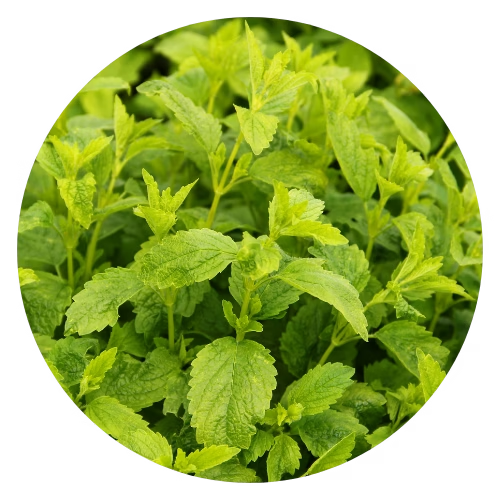Lemon Balm | Melissa officinalis
Known for its bright lemon scent and gentle calming effects, lemon balm is used both internally and topically. As a mild sedative and nervine, it helps ease stress, anxiety, and insomnia. Its antiviral and antioxidant constituents support immune health, while its carminative properties soothe digestive discomfort.

Herbal Actions and Effects on the Body
Lemon Balm (Melissa officinalis) is a well-known medicinal herb with a broad range of therapeutic benefits, primarily due to its bioactive compounds that contribute to its calming, antiviral, and cognitive-enhancing effects, making it a valuable herb for stress relief, immune support, and mental clarity.
Calming & Sedating Effects : Lemon Balm’s nervine properties supports and soothes the nervous system making it particularly useful for individuals experiencing stress, anxiety, restlessness, and insomnia.
Antiviral Properties: Lemon Balm’s antiviral effects aid in inhibiting viral replication, reducing the severity and duration of cold sores.
Cognitive Enhancement & Brain Health: Research suggests that it has a neuroprotective effect, possibly linked to its antioxidant properties and its ability to influence neurotransmitters. Clinical studies have shown that Lemon Balm can enhance memory recall, concentration, and mental clarity, making it beneficial for students or those needing cognitive support. Some research suggests that Lemon Balm may help slow cognitive decline in individuals with Alzheimer’s disease or other neurodegenerative conditions.
Cholagogue: By stimulating bile flow, lemon balm aids in the digestion of fats and supports liver function, making it beneficial for eczema and psoriasis by clearing the liver.
- Vasodilator: Lemon balm’s vasodilatory properties help in lowering blood pressure and improving circulation, offering relief from headaches and tension-related cardiovascular symptoms.
Precautions and Side Effects
Though agave has beneficial uses, certain precautions are necessary:
Skin Sensitivity: The raw sap can cause skin irritation, leading to rashes or contact dermatitis in sensitive individuals. Gloves are recommended when handling the plant to avoid irritation.
Ingestion Risks: Raw agave contains toxic compounds that can irritate the stomach if ingested in large amounts. Always avoid eating raw agave sap or leaves directly.
Pregnancy and Breastfeeding: Should be avoided as it may stimulate uterine contractions.
Fructose Content: Agave syrup is high in fructose, which, when consumed in excess, can stress the liver and impact metabolism. Moderation is advised, particularly for those with liver conditions or metabolic concerns.
- Caution when Combining Medication: Agave should not be used with immunosuppressants, digoxin, or warfarin due to potential interactions. For individuals on immunosuppressants, agave may inadvertently stimulate immune activity, which could reduce the effectiveness of these medications. Agave also affects potassium levels, potentially increasing the risk of digoxin toxicity and related heart complications, as digoxin relies on stable potassium levels for safe use. Additionally, it has mild blood-thinning properties, which can amplify the effects of warfarin, raising the risk of excessive bleeding. It’s essential to consult a healthcare provider before using agave if you are taking any of these medications.
Plant Identification, Growth, and Edible/Medicinal Parts
Agave is a hardy succulent native to arid regions in the Americas and is well-suited to warm, sunny climates.
Appearance: Agave plants have thick, fleshy leaves with sharp spines along the edges and can reach several feet in height and width. Some species produce a tall, central flower stalk after several years, which gives them the nickname “century plant.”
Growing Conditions: Agave thrives in well-drained, sandy soils and requires full sunlight. Minimal watering is needed, as agave is drought-tolerant. It grows slowly, and once it flowers—usually after 10-30 years—the main plant dies, though smaller offsets can continue growing.
Harvesting: The gel inside the leaves can be harvested by cutting mature leaves, while the core (piña) can be used in making alcoholic beverages like tequila and mezcal. The flower stalk can be roasted and eaten, though it’s primarily the sap and core that have medicinal and culinary uses.
Edible/Medicinal Parts: The main edible part is the agave syrup derived from the core. Medicinally, the gel from the leaves is used for topical applications, while the sap is sometimes processed for its antimicrobial properties.
Common Names and Origins
Agave has several common names, including century plant, American aloe, and maguey. The plant is indigenous to Mexico and the American Southwest and has long been a staple in the traditional medicine of Indigenous communities. The term “agave” is derived from the Greek word agavos, meaning “noble” or “admirable,” reflecting its resilient nature and its revered status among early peoples. As a plant that thrives in harsh conditions, agave embodies endurance and adaptability, making it a valued herb in medicinal and cultural practices.
For more detailed information about the different ways to take herbs, consider taking a course at the HomeGrown Herbalist Online School of Botanical Medicine.
